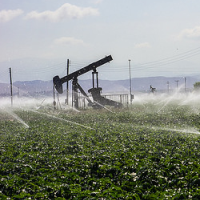Chevron Wastewater, Used on Central Valley Crops, Has a Few Troublesome Chemicals
 (photo: akahawkeyefan/Flickr)
(photo: akahawkeyefan/Flickr)
Inquiring minds want to know: What chemicals are in the 21 million gallons of Chevron oil drilling wastewater used daily to irrigate 10% of Central Valley crops?
After years of measuring contaminants using decades-old, pre-fracking standards that looked for naturally-occurring contaminants, the Central Valley Regional Water Quality Control Board ordered Chevron in April to conduct new tests. A report on those tests was turned in last week and showed petroleum hydrocarbons, acetone, an industrial solvent, and trace amounts of benzene, a carcinogen. The wastewater was tested in Chevron ponds, where it’s treated before shipment to farmers.
Benzene is not allowed in drinking water at all, but there is no standard for how much can be in water used to irrigate crops. The Central Valley produces 90% of the nation’s almonds, artichokes, olives, garlic, broccoli, nectarines, canned tomatoes, celery, apricots, strawberries and cauliflower.
Acetone exposure can lead to long-term, chronic ailments. Animal tests have linked it to “kidney, liver, and nerve damage, increased birth defects, and lowered reproduction ability of males occurred in chronically exposed animals.”
Chevron pronounced itself in compliance with existing permits based on the report’s analysis, done by Amec Foster Wheeler Environment & Infrastructure Inc. in Fresno. But the water board and an advisory committee are going to take a look at the data anyway and make an independent assessment.
“We are assembling all the data, and we will be providing them with all the data so that experts in food safety can assist us in determining if there is an issue here and whether they see anything that indicates whether immediate action is needed,” Clay Rodgers with the water board told Truthout.
The advocacy nonprofit group Water Defense, founded by actor Mark Ruffalo, did its own study of Chevron wastewater in March and found too much oil, acetone, methylene chloride and other toxic chemicals. Methylene chloride, another solvent, is strong stuff, but is not mentioned in the new test results.
Sarah Oktay, a water testing expert at the University of Massachusetts Boston, took a look at the Water Defense data and said, “I wouldn't necessarily panic, but I would certainly think I would rather not have that.”
The water board reportedly requested further testing.
The state has only recently begun to regulate hydraulic fracturing (fracking), acidization and other high-tech extraction techniques, following passage of Senate Bill 4 in 2013. The bill set in motion an attempt to at least catalogue what the oil industry was doing and where it was doing it.
Oil drilling produces about 10 barrels of wastewater for every barrel of oil. Normally, that is a major inconvenience because there is no good way to dispose of it. Oil companies use oil wastewater pits that are fraught with peril, and injection wells that pump the wastewater back into the ground (hopefully, not into an aquifer).
None of them make money like selling recycled wastewater to beleaguered farmers who are tapping out their groundwater while growing crops in the desert during a drought.
–Ken Broder
To Learn More:
Has Our Food Been Contaminated by Chevron's Wastewater? (by Daniel Ross, Truthout)
Potentially Harmful Chemicals Found in Oil Field Water Used for Irrigation (by Julie Cart, Los Angeles Times)
A California Oil Field Yields Another Prized Commodity (by Norimitsu Onishi, New York Times)
Just 5 Weeks from Finding Out What’s in the Oil Wastewater Used on Crops (by Ken Broder, AllGov California)
Technical Report: Reclaimed Water Impoundments Sampling (Amec Foster Wheeler Environment & Infrastructure, Inc.)
- Top Stories
- Controversies
- Where is the Money Going?
- California and the Nation
- Appointments and Resignations
- Unusual News
- Latest News
- California Forbids U.S. Immigration Agents from Pretending to be Police
- California Lawmakers Urged to Strip “Self-Dealing” Tax Board of Its Duties
- Big Oil’s Grip on California
- Santa Cruz Police See Homeland Security Betrayal in Use of Gang Roundup as Cover for Immigration Raid
- Oil Companies Face Deadline to Stop Polluting California Groundwater





